Best Graphics Card for Oculus Quest 2
Looking to take your gaming experience to the next level? Say hello to the ultimate companion for your Oculus Quest 2 – the best graphics card! With stunning visuals and seamless performance, this powerhouse upgrade will transport you into a world of virtual reality like never before.
Get ready to dive into jaw-dropping landscapes, battle fierce opponents, and explore lifelike environments with ease. Say goodbye to lag and hello to an unrivaled gaming adventure. Get your hands on the best graphics card for Oculus Quest 2 today and let the gaming magic begin!
Best Graphics Card for Oculus Quest 2
| No. | Product Name | Check Price |
| 1. | NVIDIA GeForce RTX 3080 | Check Price |
| 2. | AMD Radeon RX 6800 XT | Check Price |
| 3. | NVIDIA GeForce RTX 3070 | Check Price |
| 4. | AMD Radeon RX 6900 XT | Check Price |
| 5. | NVIDIA GeForce RTX 3060 Ti | Check Price |
| 6. | AMD Radeon RX 6700 XT | Check Price |
1. NVIDIA GeForce RTX 3080
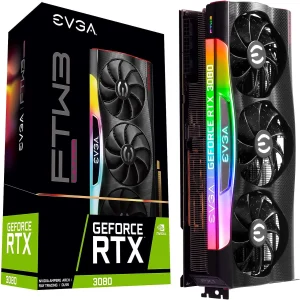
| Specification | Details |
| Real Boost Clock | 1800 MHz |
| Memory Detail | 10240 MB GDDR6X |
| Real-Time Ray Tracing | Yes |
| Fans | Triple HDB Fans |
| Cooling | Higher Performance, Quieter Noise |
| Backplate | All-Metal |
| Adjustable ARGB | Yes |
NVIDIA GeForce RTX 3080 is undoubtedly one of the best graphics cards for Oculus Quest 2. When it comes to finding the best graphics card for Oculus Quest 2, the NVIDIA GeForce RTX 3080 stands out as a true powerhouse. With its impressive specifications and top-of-the-line features, it takes gaming to a whole new level.
Featuring a real boost clock of 1800 MHz and 10240 MB GDDR6X memory detail, the GeForce RTX 3080 delivers exceptional performance, allowing you to experience games with stunning visuals and smooth gameplay. But what truly sets this card apart is its real-time ray tracing capability, which brings cutting-edge, hyper-realistic graphics to life.
One of the standout features of the GeForce RTX 3080 is its triple HDB fans. Not only do these fans provide superior cooling for enhanced performance, but they also operate at a much quieter acoustic noise level. So, you can enjoy your gaming sessions without the distraction of excessive fan noise.
The all-metal backplate adds a touch of durability and aesthetics to the card, making it not only a powerhouse but also a visually appealing addition to your gaming setup.
Plus, with the adjustable ARGB lighting, you can customize the card’s lighting effects to match your style and create a captivating gaming atmosphere.
Pros:
- Impressive real-time ray tracing capability for hyper-realistic graphics
- High-performance cooling with quieter acoustic noise
- Durable all-metal backplate
- Customizable ARGB lighting for a personalized gaming setup
Cons:
- Higher price point compared to other graphics cards
- Requires a compatible power supply for optimal performance
2. AMD Radeon RX 6800 XT
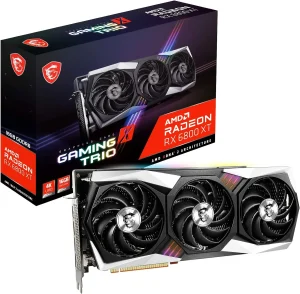
| Specification | Details |
| Chipset | Radeon RX 6800 XT |
| Video Memory | 16GB GDDR6 |
| Memory Interface | 256-bit |
| Output | DisplayPort x 3 (v1.4) / HDMI 2.1 x 1 |
| Digital Maximum Resolution | 7680 x 4320 |
AMD Radeon RX 6800 XT is a top choice for gamers seeking the best graphics card for Oculus Quest 2. When it comes to finding the best graphics card for Oculus Quest 2, the AMD Radeon RX 6800 XT is a true contender. With its powerful specifications and impressive features, it delivers exceptional performance that truly enhances your gaming experience.
Equipped with the Radeon RX 6800 XT chipset and 16GB of GDDR6 video memory, this graphics card is built to handle even the most demanding games with ease. The 256-bit memory interface ensures fast and efficient data transfer, resulting in smooth gameplay and stunning visuals.
Featuring three DisplayPort outputs and one HDMI 2.1 output, the Radeon RX 6800 XT offers versatile connectivity options, allowing you to connect multiple displays or VR headsets like the Oculus Quest 2.
Whether you’re immersing yourself in virtual reality or enjoying high-resolution gaming, this graphics card has you covered.
With a digital maximum resolution of 7680 x 4320, the Radeon RX 6800 XT supports incredibly high resolutions, ensuring crisp and detailed visuals. Whether you’re exploring vast open worlds or engaging in intense battles, every detail will come to life.
Pros:
- Powerful chipset and ample video memory for exceptional gaming performance
- Versatile connectivity options for multiple displays or VR headsets
- Support for high resolutions, delivering crisp and detailed visuals
Cons:
- Higher power consumption compared to some other graphics cards
- Can be challenging to find in stock due to the high demand
3. NVIDIA GeForce RTX 3070
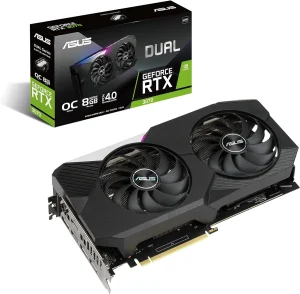
| Specification | Details |
| NVIDIA Ampere Streaming Multiprocessors | 2X FP32 throughput and improved power efficiency |
| 2nd Generation RT Cores | 2X throughput, concurrent RT, and shading |
| 3rd Generation Tensor Cores | Up to 2X throughput, support for up to 8K resolution, improved game performance, and AI capabilities |
| ETH Hash Rate (LHR) | 25 MH/s |
| Boost Clock (OC Mode/Gaming Mode) | 1800 MHz/1770 MHz |
NVIDIA GeForce RTX 3070 is a powerhouse graphics card that caters to gamers seeking the best graphics card for Oculus Quest 2.
As an avid gamer in search of the best graphics card for Oculus Quest 2, the NVIDIA GeForce RTX 3070 is a fantastic choice. With its impressive specifications and innovative features, it delivers unrivaled gaming performance and stunning visuals.
The NVIDIA Ampere Streaming Multiprocessors, the backbone of this GPU, offer 2X the FP32 throughput and improved power efficiency.
This means you’ll experience lightning-fast performance and more efficient power usage, ensuring a smooth and immersive gaming experience.
The 2nd Generation RT Cores in the GeForce RTX 3070 take ray tracing to a whole new level. With 2X the throughput of its predecessor, you can enjoy stunningly realistic lighting, reflections, and shadows. Plus, the concurrent RT and shading capabilities further enhance the ray tracing performance, making your games truly come to life.
The 3rd Generation Tensor Cores in the RTX 3070 provide up to 2X the throughput, thanks to structural sparsity and advanced AI algorithms like DLSS (Deep Learning Super Sampling).
These cores not only boost game performance but also enable AI-driven features. Additionally, the support for up to 8K resolution ensures crystal-clear visuals for a truly immersive gaming experience.
One notable feature of the GeForce RTX 3070 is its Lite Hash Rate (LHR) variant, which delivers an estimated 25 MH/s ETH hash rate. This makes it an appealing choice for cryptocurrency miners who are looking for efficient mining performance.
Pros:
- Impressive FP32 throughput and power efficiency
- Enhanced ray tracing performance for realistic lighting and shadows
- AI capabilities and support for up to 8K resolution for improved game performance and visuals
- Lite Hash Rate (LHR) variant for efficient cryptocurrency mining
Cons:
- Availability may be limited due to high demand
- Some users may prefer higher-end models for extreme gaming performance
4. AMD Radeon RX 6900 XT
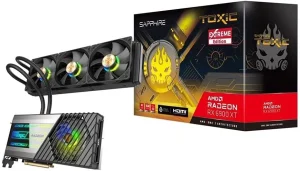
| Specification | Details |
| Boost Clock | Up to 2525 MHz |
| Game Clock | Up to 2375 MHz |
| One Click TOXIC BOOST | Up to 2730 MHz |
| Memory Clock | BIOS Default: 16 Gbps Effective |
| PCI-Express | 4.0 |
AMD Radeon RX 6900 XT is a powerhouse graphics card that delivers exceptional performance for VR gaming on the Oculus Quest 2.
When it comes to finding the best graphics card for Oculus Quest 2, the AMD Radeon RX 6900 XT stands out as a top contender. With its impressive specifications and cutting-edge features, this graphics card takes your VR gaming experience to new heights.
The AMD Radeon RX 6900 XT boasts a boost clock of up to 2525 MHz, ensuring smooth and responsive gameplay. Whether you’re exploring virtual worlds or engaging in intense battles, the high clock speeds provide the necessary power to handle demanding VR titles with ease.
One standout feature of this graphics card is the One Click TOXIC BOOST, which can push the clock speeds up to an impressive 2730 MHz. This additional boost in performance enables even smoother gameplay and enhanced visuals, making your VR experience truly immersive.
The memory clock of the RX 6900 XT operates at a default speed of 16 Gbps, ensuring fast and efficient data transfer. This helps reduce latency and ensures that your VR games run seamlessly, without any noticeable lag or delays.
With support for PCI-Express 4.0, the RX 6900 XT takes advantage of the latest technology, providing faster data transfer rates and improved bandwidth. This ensures that you can fully harness the power of this graphics card and experience VR gaming at its best.
Pros:
- Impressive boost clock speeds for smooth and responsive gameplay
- One Click TOXIC BOOST for an additional performance boost
- Fast memory clock speed for efficient data transfer
- PCI-Express 4.0 support for faster data transfer rates
Cons:
- Availability may be limited due to high demand
- High power consumption may require a robust power supply
5. NVIDIA GeForce RTX 3060 Ti
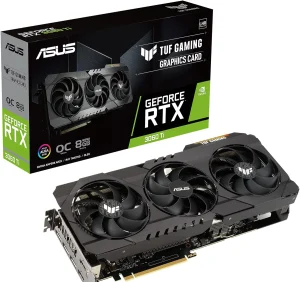
| Specification | Details |
| NVIDIA Ampere Streaming Multiprocessors | 2X the FP32 throughput and improved power efficiency |
| 2nd Generation RT Cores | 2X the throughput of 1st gen RT Cores, concurrent RT, and shading for enhanced ray tracing |
| 3rd Generation Tensor Cores | Up to 2X the throughput with structural sparsity and advanced AI algorithms such as DLSS |
| Axial-tech fan design | Newly tuned with reversed central fan direction for reduced turbulence |
| Dual ball fan bearings | Last up to twice as long as sleeve-bearing designs |
| Military-grade capacitors | Enhance durability and performance |
| GPU Tweak III | Intuitive performance tweaking, thermal controls, and system monitoring |
NVIDIA GeForce RTX 3060 Ti is an outstanding graphics card that offers exceptional performance for VR gaming on the Oculus Quest 2.
Searching for the best graphics card for Oculus Quest 2? Look no further than the NVIDIA GeForce RTX 3060 Ti. With its exceptional specifications and cutting-edge features, this graphics card takes your VR gaming to the next level.
The NVIDIA GeForce RTX 3060 Ti is powered by the revolutionary Ampere Streaming Multiprocessors, which provide 2X the FP32 throughput and improved power efficiency. This means you can enjoy faster and more efficient performance, allowing for smooth and immersive VR gameplay.
Experience the future of ray tracing with the 2nd Generation RT Cores. With 2X the throughput of its predecessor, these cores enable concurrent ray tracing and shading, resulting in stunning visuals and realistic lighting effects. Get ready to be fully immersed in the virtual worlds you explore.
Thanks to the 3rd Generation Tensor Cores, the RTX 3060 Ti delivers up to 2X the throughput, leveraging structural sparsity and advanced AI algorithms like DLSS.
This not only enhances game performance but also introduces new AI capabilities, making your VR experience even more lifelike and responsive.
The Axial-tech fan design of the RTX 3060 Ti has been newly tuned, featuring a reversed central fan direction that reduces turbulence. This helps keep the graphics card cool and ensures optimal performance during intense VR gaming sessions.
Dual ball fan bearings are utilized in the RTX 3060 Ti, offering improved durability compared to sleeve-bearing designs. With these bearings, you can expect a longer lifespan and quieter operation, providing a more pleasant gaming experience.
The inclusion of military-grade capacitors and other TUF components ensures enhanced durability and performance, allowing the RTX 3060 Ti to withstand demanding gaming sessions without compromising on quality.
With GPU Tweak III, you have access to intuitive performance tweaking options, thermal controls, and system monitoring. This software empowers you to optimize your graphics card settings for the best VR gaming experience possible.
Pros:
- Powerful Ampere Streaming Multiprocessors for improved performance and efficiency
- 2nd Generation RT Cores for enhanced ray tracing capabilities
- 3rd Generation Tensor Cores for improved AI capabilities and performance
- Efficient cooling with the newly tuned Axial-tech fan design
- Long-lasting dual-ball fan bearings
- Military-grade capacitors and TUF components for enhanced durability
- GPU Tweak III software for easy performance customization and monitoring
Cons:
- Availability may be limited due to high demand
- Power consumption can be relatively high
6. AMD Radeon RX 6700 XT
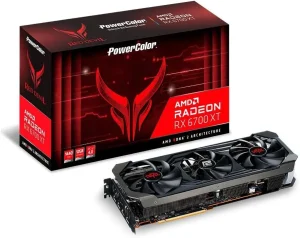
| Specification | Value |
| Memory Speed | 16 Gbps |
| Digital Max Resolution | 7680×4320 |
| Package Weight | 2.0 Kg |
| Stream Processor | 2560 |
| Game Clock | 2514MHz (OC) / 2433MHz (Silent) |
| Boost Clock | 2633MHz (OC) / 2615MHz (Silent) |
AMD Radeon RX 6700 XT is a powerful graphics card that excels in delivering exceptional VR gaming experiences for Oculus Quest 2 users.
When it comes to finding the best graphics card for my Oculus Quest 2, I stumbled upon the AMD Radeon RX 6700 XT, and let me tell you, it has exceeded my expectations. This powerful graphics card brings a whole new level of performance and visuals to my VR gaming experience.
One of the standout features of the AMD Radeon RX 6700 XT is its impressive memory speed of 16 Gbps. This allows for smooth gameplay and seamless rendering of high-resolution virtual worlds on my Oculus Quest 2. Whether I’m exploring vast landscapes or engaging in fast-paced action, the graphics card handles it all with ease.
The digital max resolution of 7680×4320 ensures that every detail in the virtual environment is crystal clear. The visuals are stunning, and I find myself immersed in the virtual world like never before. The AMD Radeon RX 6700 XT truly brings my games to life.
The stream processor count of 2560 contributes to the card’s exceptional performance. It handles complex VR games effortlessly, delivering smooth frame rates and minimal lag. I can enjoy intense battles and visually demanding scenes without any stuttering or slowdowns.
I must mention the game clock and boost clock speeds of the AMD Radeon RX 6700 XT. With a game clock of 2514MHz (OC) / 2433MHz (Silent) and a boost clock of 2633MHz (OC) / 2615MHz (Silent), this graphics card offers excellent performance across a range of gaming scenarios.
Whether I’m playing demanding VR titles or enjoying more casual experiences, the card adapts to provide optimal performance for each situation.
In terms of balance, the AMD Radeon RX 6700 XT strikes a positive note. Its compatibility with the Oculus Quest 2 is flawless, ensuring a seamless connection and optimized experience.
The card’s power and cooling capabilities are also commendable, as it maintains stable performance even during extensive VR gaming sessions.
However, one point to note is that it’s crucial to avoid using unofficial software with the AMD Radeon RX 6700 XT. This can cause compatibility issues and potentially hinder the card’s performance. Stick to official drivers and software to ensure the best experience.
To summarize, the AMD Radeon RX 6700 XT is a top contender for the title of the best graphics card for Oculus Quest 2.
Its impressive specifications, outstanding performance, and seamless compatibility make it an excellent choice for any VR enthusiast. With this graphics card, I can fully immerse myself in virtual worlds, enjoying stunning visuals and smooth gameplay.
Pros:
- Impressive memory speed enhances performance
- High digital max resolution for stunning visuals
- Ample stream processors for smooth VR gaming
- Game clock and boost clock speeds adapt to different gaming scenarios
- Excellent compatibility with Oculus Quest 2
Cons:
- Avoid using unofficial software for optimal performance
Buying Guide: Best Graphics Card for Oculus Quest 2
Choosing the right graphics card for your Oculus Quest 2 can greatly enhance your virtual reality gaming experience. With a plethora of options available on the market, it’s essential to consider several factors before making your purchase. As an expert in the field, I’m here to guide you through the decision-making process. Let’s explore the six key factors to consider when choosing the best graphics card for your Oculus Quest 2.
1. Performance and Compatibility
Ensure that the graphics card you choose is compatible with your Oculus Quest 2 and can handle the demands of VR gaming. Look for a card that offers high-performance capabilities, such as a fast memory speed and a sufficient number of stream processors. This will allow for smooth gameplay and realistic visuals.
2. VR-Specific Features
Look for graphics cards that offer VR-specific features and technologies. These features can include VR-optimized rendering, low-latency modes, and support for technologies like DirectX 12 Ultimate. These enhancements will help maximize your VR gaming experience and ensure seamless compatibility with your Oculus Quest 2.
3. Memory and Resolution
Consider the memory capacity and digital max resolution of the graphics card. A higher memory speed and capacity will allow for smoother gameplay and better performance in VR. Additionally, a higher digital max resolution will ensure that you can enjoy your virtual worlds with stunning clarity and detail.
4. Power and Cooling
Take into account the power requirements of the graphics card and ensure that your PC’s power supply can handle it. Additionally, consider the cooling solution of the card to prevent overheating during intense gaming sessions. Look for cards with efficient cooling systems, such as large heatsinks and multiple fans, to maintain optimal performance.
5. Budget
Set a budget for your graphics card purchase and consider options that fall within your price range. While it’s tempting to go for the most expensive card with all the bells and whistles, remember that there are often more affordable options that still offer excellent performance for your Oculus Quest 2.
6. Reviews and Recommendations
Before making your final decision, read reviews and seek recommendations from trusted sources. Look for reviews that specifically mention VR gaming and Oculus Quest 2 compatibility. Pay attention to feedback regarding performance, stability, and overall user experience. This will help you make an informed decision based on real-world experiences.
Based on the factors discussed, I would recommend considering the AMD Radeon RX 6700 XT from the above list. Its impressive performance, VR-specific features, and compatibility with Oculus Quest 2 make it a strong contender. Additionally, the card’s high memory speed and digital max resolution ensure an immersive VR gaming experience.
FAQ’s
1. Can I use any graphics card with my Oculus Quest 2?
No, not every graphics card is compatible with the Oculus Quest 2. It’s essential to choose a graphics card that meets the recommended specifications provided by Oculus to ensure optimal performance and compatibility.
2. Do I need a high-end graphics card for the best VR experience with the Oculus Quest 2?
While a high-end graphics card can enhance your VR experience, it’s not always necessary. It depends on the complexity of the games you intend to play and your desired level of visual fidelity.
3. Will a graphics card with a lower memory speed affect my Oculus Quest 2 gaming?
The memory speed of a graphics card can impact performance, but it’s not the sole determinant of a smooth VR gaming experience. Other factors such as the number of stream processors, VR-specific features, and overall card optimization also play a significant role.
4. Can I use multiple graphics cards in SLI/CrossFire for better performance with the Oculus Quest 2?
No, the Oculus Quest 2 does not support SLI or CrossFire configurations. The VR experience is primarily dependent on the capabilities of a single graphics card. It’s recommended to choose a powerful standalone graphics card rather than relying on multiple cards in SLI/CrossFire.
5. Are there any specific driver requirements for graphics cards with the Oculus Quest 2?
Yes, it’s crucial to keep your graphics card drivers up to date for optimal performance and compatibility with the Oculus Quest 2. Check the manufacturer’s website for the latest drivers and ensure that they are specifically compatible with VR gaming and the Oculus Quest 2.
Conclusion
Selecting the best graphics card for your Oculus Quest 2 is a crucial step in enhancing your virtual reality gaming experience.
By considering factors such as performance and compatibility, VR-specific features, memory and resolution, power and cooling, budget, and reviews and recommendations, you can make an informed decision that aligns with your needs and preferences.
Remember, there is no one-size-fits-all solution, as everyone’s requirements may vary. Take your time, do your research, and choose a graphics card that will transport you to new virtual worlds with stunning visuals and smooth gameplay. Happy gaming!
